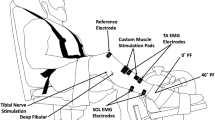Abstract
The purpose of this investigation was to examine the effects of voluntary muscular fatigue in one lower limb and determine whether a ‘cross-over’ of fatigue is evident in the contralateral limb. Twenty-eight subjects (13 males and 15 females) performed a series of voluntary and evoked isometric contractions of both the dominant (exercised) and non-dominant (non-exercised) leg extensor muscles, prior to and after a fatigue protocol consisting of a 100-s sustained maximal isometric contraction (MVC) performed by the dominant limb only. Force values and surface electromyography (EMG) from the vastus lateralis muscle were obtained allowing for the determination of twitch and compound action potential (M-wave) values. Maximal twitch tension and peak-to-peak amplitude were significantly decreased after the fatigue test in the dominant limb, as was maximal voluntary force (∼65 N reduction), EMG activity (∼0.1 mV decrease) and voluntary activation (∼17% decline). However, no significant changes were observed in the non-dominant limb with respect to twitch and M-wave properties nor in MVC force. The voluntary activation of the non-dominant limb decreased significantly by 8.7% after the fatigue test, which was performed only on the dominant limb. The results of the present study suggest that the decrease in force production in the exercised limb was primarily related to peripheral fatigue mechanisms, with central fatigue making a lesser contribution. Centrally mediated mechanisms appear to be the sole contributor to fatigue in the non-exercised limb suggesting an anticipatory fatigue response and a ‘cross-over’ of central fatigue between the exercised and non-exercised contralateral limb.






Similar content being viewed by others
References
Allen GM, Gandevia SC, McKenzie DK (1995) Reliability of measurements of muscle strength and voluntary activation using twitch interpolation. Muscle Nerve 18:593–600
Allen GM, Gandevia SC, McKenzie DK (1998) Twitch interpolation of the elbow flexor muscles at high forces. Muscle Nerve 21:318–328
Allman BL, Rice CL (2002) Neuromuscular fatigue and aging: central and peripheral factors. Muscle Nerve 25:285–296
Avela J, Kyrolainen H, Komi PV (2001) Neuromuscular changes after long lasting mechanically and electrically elicited fatigue. Eur J Appl Physiol 85:317–325
Babault N, Pousson M, Michaut A, Van Hoecke J (2003) Effect of quadriceps femoris muscle length on neural activation during isometric and concentric contractions. J Appl Physiol 94:983–990
Bellemare F, Bigland-Ritchie B (1984) Assessment of human diaphragm strength and activation using phrenic nerve stimulation. Respir Physiol 58:263–277
Bigland-Ritchie B, Woods JJ (1984) Changes in muscle contractile properties and neural control during human muscular fatigue. Muscle Nerve 7:691–699
Duchateau J, Hainaut K (1985) Electrical and mechanical failures during sustained and intermittent contractions in humans. J Appl Physiol 58:942–947
Gandevia SC (2001) Spinal and supraspinal factors in human muscle fatigue. Physiol Rev 81:1725–1789
Gandevia SC, Allen GM, Butler JE, Taylor JL (1996) Supraspinal factors in human muscle fatigue: evidence for suboptimal output from the motor cortex. J Physiol 490:529–536
Grabiner MD, Owings TM (1999) Effects of eccentrically and concentrically induced unilateral fatigue on the involved and uninvolved limbs. J Electromyogr Kinesiol 9:185–189
Kaufman MP, Longhurst JC, Rybicki KJ, Wallach JH, Mitchell JH (1983) Effects of static muscular contraction on impulse activity of groups III and IV afferents in cats. J Appl Physiol 55:105–112
Marino FE (2004) Anticipatory regulation and the avoidance of catastrophe during exercise-induced hyperthermia. Comp Biochem Physiol B 139:561–569
Marino FE, Lambert MI, Noakes TD (2004) Superior performance of African runners in warm humid but not in cool environmental conditions. J Appl Physiol 96:124–130
Martin PG, Marino FE, Rattey J, Kay D, Cannon J (2005) Reduced voluntary activation of human skeletal muscle during shortening and lengthening contractions in whole body hyperthermia. Exp Physiol 90:225–236
Merton P (1954) Voluntary strength and fatigue. J Physiol 123:553–564
Millet GY, Lepers NA, Maffiuletti N, Babault V, Martin V, Lattier G (2002) Alterations of neuromuscular function after an ultramarathon. J Appl Physiol 92:486–492
Mullany H, O'Malley M, St Clair Gibson A, Vaughan C (2002) Agonist antagonist common drive during fatiguing knee extension efforts using surface electromyography. J Electromyogr Kinesiol 12:375–384
Noakes TD, Calbet JAL, Boushel R, Søndergaard H, Rådegran G, Wagner PD, Saltin B (2004) Central regulation of skeletal muscle recruitment explains the reduced maximal cardiac output during exercise in hypoxia. Am J Physiol Regul Integr Comp Physiol 287:996–1002
Nybo L, Nielsen B (2001) Hyperthermia and central fatigue during prolonged exercise in humans. J Appl Physiol 91:1055–1060
Nybo L, Secher NH (2004) Cerebral perturbations provoked by prolonged exercise. Prog Neurobiol 72:223–261
Psek JA, Cafarelli E (1993) Behaviour of coactive muscles during fatigue. J Appl Physiol 74:170–175
Rauch HGL, St Clair Gibson A, Lambert EV, Noakes TD (2005) A signalling role for muscle glycogen in the regulation of pace during prolonged exercise. Br J Sports Med 39:34–38
Rosenbaum DA (1977) Selective adaptation of ‘command neurons’ in the human motor system. Neuropsychologia 15:81–91
Saboisky J, Marino FE, Kay D, Cannon J (2003) Exercise heat stress does not reduce central activation to non-exercised human skeletal muscle. Exp Physiol 88:783–790
St Clair Gibson A, Noakes TD (2004) Evidence for complex system integration and dynamic neural regulation of skeletal muscle recruitment during exercise in humans. Br J Sports Med 38:797–806
Todd G, Petersen NT, Taylor JL, Gandevia SC (2003) The effect of a contralateral contraction on maximal voluntary activation and central fatigue in elbow flexor muscles. Ex Brain Res 103:308–313
Todd G, Butler JE, Taylor JL, Gandevia SC (2005) Hyperthermia: a failure of the motor cortex and the muscle. J Physiol 563:621–631
Ulmer H-V (1996) Concept of an extracellular regulation of muscular metabolic rate during heavy exercise in humans by psychophysiological feedback. Experientia 52:416–420
Walton DM, Kuchinad RA, Ivanova TD, Garland SJ (2002) Reflex inhibition during muscle fatigue in endurance-trained and sedentary individuals. Eur J Appl Physiol 86:462–468
Zijdewind I, Zwarts MJ, Kernell D (1998) Influence of a voluntary fatigue test on the contralateral homologous muscle in humans. Neurosci Lett 253:41–44
Author information
Authors and Affiliations
Corresponding author
Rights and permissions
About this article
Cite this article
Rattey, J., Martin, P.G., Kay, D. et al. Contralateral muscle fatigue in human quadriceps muscle: evidence for a centrally mediated fatigue response and cross-over effect. Pflugers Arch - Eur J Physiol 452, 199–207 (2006). https://doi.org/10.1007/s00424-005-0027-4
Received:
Accepted:
Published:
Issue Date:
DOI: https://doi.org/10.1007/s00424-005-0027-4




